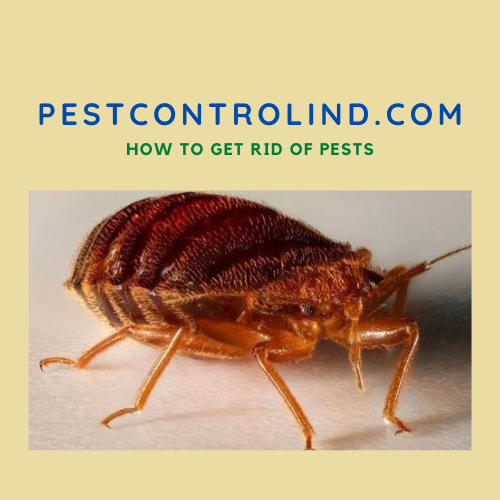Wood-eating insects are xylophagous insects that have for nature, in the larval stage for the most part, to nibble dry wood to feed themselves. In the wild, they are of considerable help for the biological balance of species in general.
Wood-eating insects are excellent cleaners of forests. They clear the environment of dead wood to let younger wood grow in its place. They are a kind of gas pedal for the renewal of forests in particular and of nature in general.
These wood-eating insects become harmful to humans as soon as they attack houses. They become harmful to humans when they invade their immediate environment, i.e. when they attack their furniture.
Wood-eating insects become even more dangerous when they attack not only furniture or other wooden trinkets but also the wooden structures of buildings such as the frame or beams.
I. Recognizing wood-eating insects
Wood-eating insects attack preferably dry wood and their existence is indicated by exit holes that open on the surface of the wood, by the fall of dust, or simply by the larvae of the insects that are found when the wood is destroyed.
The damage they cause is very important because they reduce the physical property of the wood and when the galleries become too large, the wood can be said to be completely dead and destroyed.
Wood-eating insects can live in trees still standing, in recently harvested wood, in processed wood, and even in finished products such as furniture, flooring, etc.
Each wood-boring insect, from birth to death, has three forms: egg, larva, and adult insect, ready to reproduce and lay the next generation, to start the same life cycle.
This biological cycle is one of the important characteristics in the identification of those insects that cause the attack of the wood. And by observing this cycle, we can easily recognize the wood-eating insects responsible for the infestation to choose the tools and means necessary to eradicate them.
Almost all insects that eat dry wood cause damage in the form of larvae. Protecting wood from insect infestations is more difficult than protecting it from fungi.
Wood-boring insect worms are detectable by the eye of the specialist. A hole 3 mm wide and 5 mm long is an indicator that it is a Capricorn. A slight nibbling sound of the insect can be heard by the ear glued to the wood.
A 4 mm wide hole is a sign of beetles in the wood. A steady thumping sound from their nibbling can be heard if you put your ear to the wood. The beetles make galleries in all directions and leave coarse wormholes.
Lyctus beetles generally make small holes 1 mm wide in the wood and their worming is fine and well-packed.
II. Which insects eat wood
There are several species of wood-eating insects that can be divided into four main families.
- Beetles: several species such as Melandryidesn, Anobiides, Meloides…
- Lepidoptera: cossids, sesiids …
- Isoptera: termites belong to this family.
- Hymenoptera: formicides, siricides, Myrmicides …
Also, we can say that we have two types of wood-eating insects.
We have the insects that eat fresh wood, that is to say, attacking mainly trees in orchards and forests, causing in case of large infestations huge economic losses for farmers. These insect pests generally prefer to invade already diseased trees or those that have just been felled with a moisture content generally exceeding 30%.
On the other hand, some insects eat dry wood. These insects mainly attack the wood of buildings or furniture.
III. Main insects that eat wood
We are going to quote the main xylophagous insects known in France or which have great notoriety in the world that they acquired by making great devastations.
1. The brown powderpost beetle (lyctus brunneus)
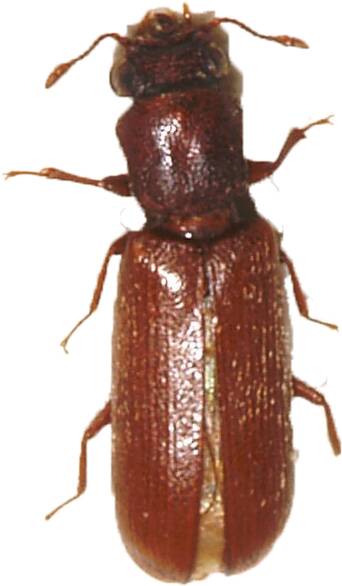
It is an insect of length going from 2 mm to 8 mm of color rather red-brown with a thin body with rows of points on its back. Its head is much darker than its body.
The size of its larva is about 7 mm which has the shape of a whitish worm. The insect remains in the state of a nymph for between 2 to four weeks before flying away by a hole of 1,8 mm. This flight takes place between the end of April and the end of July.
The attacks of the brown bark beetle can destroy a piece of furniture or a wooden frame over several generations. This wood-eating insect prefers to focus on exotic wood doors.
Life Cycle:
The adult female lyctus lives about 6 weeks after fledging while the male lives only 2 to 3 weeks at most. While mating, the female of the brown bark beetle deposits her eggs (from 150 to 200 eggs during a lifetime) in very fine vessels of the wood. Then begins a larval cycle that can last from 6 to 12 months depending on climatic conditions and ambient heat.
The holes dug by the larvae are about 1 mm in diameter. They are generally recognized by the fine and tightly packed wormholes they leave behind. The direction of their burrowing usually corresponds to the direction of the wood grain.
2. Deathwatch beetle (Xestobium rufovillosum)
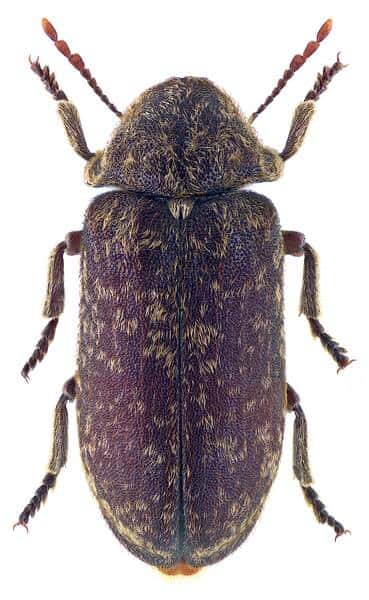
It is, with a few others, among the best-known wood-eating insects in England. Its nickname is the death clock because of the clock-like sound the male makes in the wood when making mating calls for the female.
This insect which eats mainly old wood prefers the one with a moisture content exceeding 22%. It can measure up to 8 mm. Its flight is done between April and May by a hole of flight of 3,5 mm. Its color is a dark brown with a sort of yellowish hair on the head and elytra.
Life Cycle:
The female death watch beetle may lay between 30-60 eggs during her lifetime, which will hatch between 2-8 weeks. The larvae can stay in the wood for 3 to 6 years causing great damage to the wood. And sometimes it can go up to 10 years if the external conditions are not very favorable.
The larva is white, tending towards white. They cause the most damage in infested houses. They usually attack beams and frames.
3. The furniture beetle (anobium punctatum)
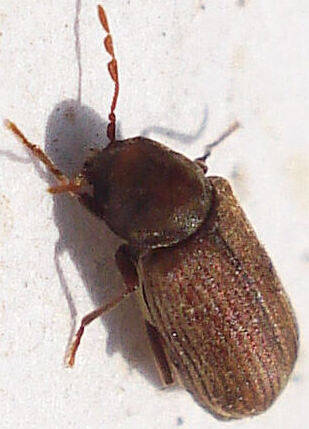
The furniture beetle is a wood-eating insect of 3 to 5 mm in length, very well known in France for the devastation it causes in houses and public buildings such as libraries and museums.
Its color is dark brown sometimes turning to almost black, having a hooded head with rows of dots on its head and elytra. Its flight hole is 1 to 2 mm in diameter. It prefers to attack wood on the surface and avoids the heart of the wood unless it has a lot of moisture, following a flood for example.
This wood-eating insect attacks the wood of staircases, parquet floors, and paintings hung on walls and books in libraries.
Life Cycle:
The female furniture beetle can lay 20 to 30 eggs during her lifetime, which she places in small cracks in the wood. The larvae develop throughout 1 to 3 years and can even live up to 10 years when temperature conditions and wood quality are not favorable.
The holes dug by the larvae are 1 to 2 mm maximum. The worming is rather fine. The flight takes place between April and August.
4. The wood weevil (Euophryum)
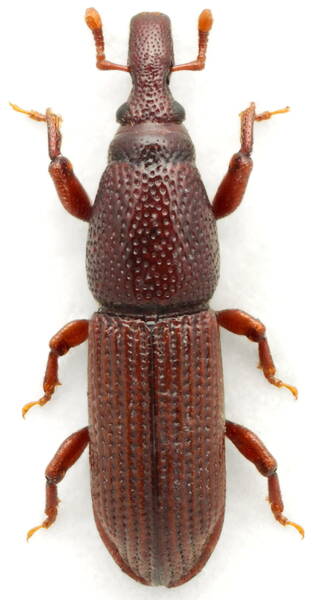
It is a xylophagous insect of the order Coleoptera. Its adult size is 2 to 5 mm long. The female lays about 30 eggs in cracks and crevices of wood.
The color of the wood weevil ranges from reddish brown to completely black with sometimes white spots on the head and elytra. Its flight hole is 2 to 3 mm.
The weevil has a rostrum and 3 pairs of legs.
Life cycle:
The eggs of the wood weevil hatch about 15 days after being deposited in a wood slot. The larvae live in the wood by digging tunnels of about one mm during a period ranging from 6 months to one year.
They usually only attack wet wood but can move to dry wood if left unattended.
5. The house longhorn beetle (hylotrupes bajulus)
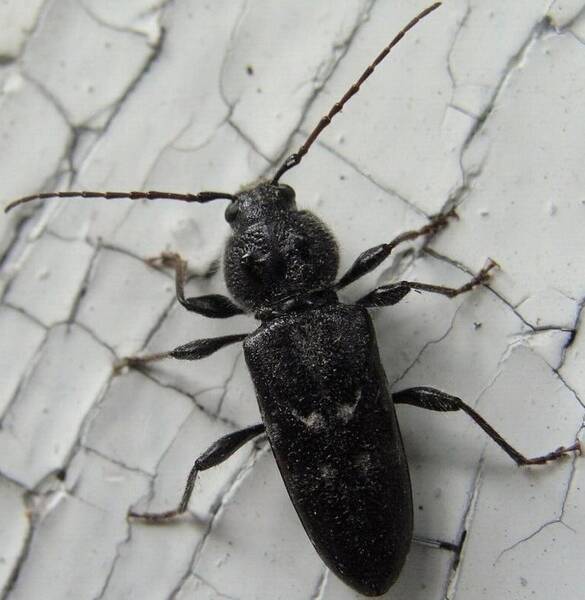
This xylophagous insect is a wood eater from 1 to 3 cm long. Its color is brown to black with hairs on the upper back, and the upper part of the thorax.
The female is slightly larger than the male. She lays, at the end of the summer about 140 to 200 eggs in the infractuosities of the wood.
The oval-shaped flight hole measures between 5 to 10 mm. The sound of the larva in the wood is easily recognized by connoisseurs.
Life cycle:
The larval duration of the house beetle can range from 4 to 10 years, or more. The larvae can cause enormous damage to beams, frames, and other wooden constructions. The house longhorn beetle is perhaps one of the worst wood-eating insect pests in France and Europe.
6. Termites
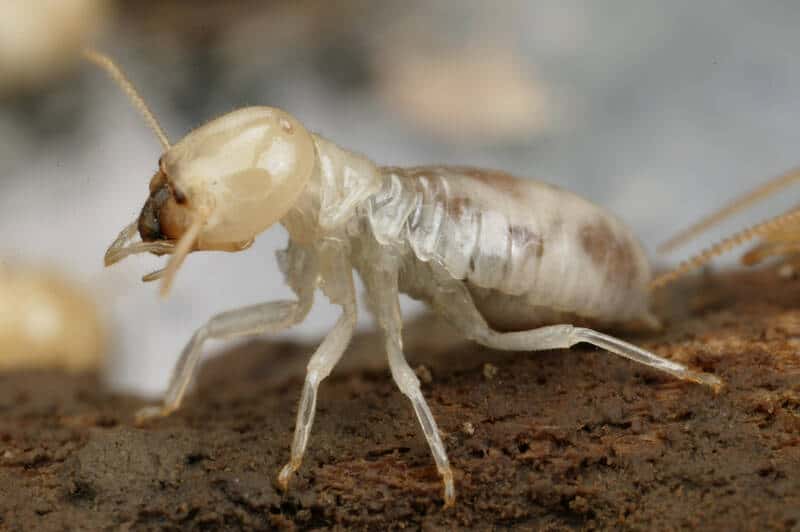
Termites are the most common wood-eating insects in the world and are the ones that do the most damage in residential and public buildings. There are more than 2500 species worldwide.
Life cycle:
The termite life cycle goes through several stages, including egg, nymph, and various adult stages. Termites are social insects, which means that they live in organized colonies with a division of labor between different groups called castes. Here is an overview of the termite life cycle:
- Egg: The termite queen lays eggs that hatch into larvae. The amount of eggs laid varies depending on the termite species and the size of the colony.
- Larva: The larvae are fed and cared for by the workers. After several molts, the larvae become pupae.
- Pupa: Pupae develop into different adult castes, depending on the needs of the colony and the chemical signals exchanged between individuals.
- Adult castes: Adult termites are divided into three main castes:
- Workers: They are responsible for foraging, nest maintenance, tunneling, and caring for the young and other members of the colony. Workers are usually white or translucent and wingless.
- Soldiers: Soldier termites protect the colony from predators such as ants and other insects. They have larger heads and more powerful mandibles than the workers. Soldiers are also usually white or translucent and have no wings.
- Breeders: This caste includes the queen, king, and secondary breeders (also called “swarmers”). The primary reproducers, the queen and king, are the only termites capable of reproducing within the colony. The queen can live for years and lay thousands of eggs a day. The swarm termites, which are the future breeders, are winged and leave the colony on a mating flight to find a mate and start a new colony.
- Swarming: Swarming termites leave their home colony in large numbers to form new colonies. Once they find a mate and a suitable site to establish a new colony, they shed their wings and begin laying eggs to form the new colony.
The life cycle of termites varies depending on the species and environmental conditions, but in general, it can last from a few months to several years.
And if you want to know how to get rid of termites, then you can read our article about eliminating termites with heat. Here.
Useful Links:
https://en.wikipedia.org/wiki/Lyctus_brunneus
